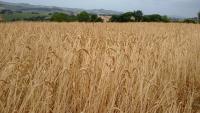
The production of organic bread wheat is almost exclusively reliant on modern wheat cultivars, as they deliver the protein contents demanded in the marketplace. This requires careful management of the crop plants’ nitrogen supply. In their joint four-year CerQual project, FiBL, Agroscope and Agridea investigated the possibilities of producing organic quality bread grains in low-fertility situations. In a network comprised of a dozen farms in Romandy, the project trialled the cultivation of little-used and relict cereal varieties that also thrive under less intensive conditions: einkorn wheat, emmer wheat, spelt, rye, bread triticale and various further types of wheat. The analysis included soil quality parameters as well as factors determining agronomic, baking and nutritional quality.
Baking quality and nutritional physiology
Baking quality varies greatly from one cultivar to another; nutritional characteristics are determined by protein content, dietary fibre, vitamins and minerals, and plant micronutrients. Cereal grains also contain fermentable components called FODMAPs that are poorly absorbed in the small intestine and can trigger food intolerances. A logical approach to processing therefore aims at preserving the cereal grains’ original quality while achieving a conversion of the least digestible components.
Integrated production chains for integral quality
But how do the little-used grain cultivars get from farms to mills to bakeries and ultimately to consumers? We also addressed this question as part of the project, studied the marketplace, considered sociological aspects and conducted interviews with farmers and artisanal bakers to elucidate their positive and negative experiences. It is clear that high-quality production necessitates the coordination of all steps involved. This includes a choice of species and cultivars adapted to the conditions on site, gentle milling, especially on natural millstones, and long proofing using natural sourdough. Today, this approach is mainly employed by farmers and bakers working in cooperative partnerships. And while this is certainly a niche trade, it is up-and-coming. The little-used and relict grain cultivars make it possible to offer a wider range of artisanal specialty breads.
Information and contacts about the project at this LINK
Source: FIBL



